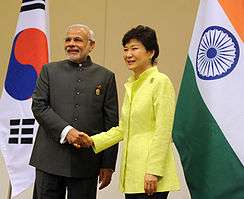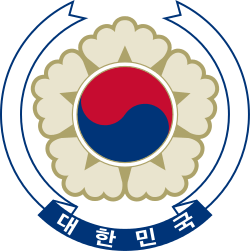India–South Korea relations

India–South Korea relations have been relatively strong from 2,000 of years, although more progress arose during the past three decades Korea and India share a lot of similarities in every aspect. Since the formal establishment of the diplomatic ties between the two countries in 1973, several trade agreements have been reached: Agreement on Trade Promotion and Economic and Technological Co-operation in 1974; Agreement on Co-operation in Science & Technology in 1976; Convention on Double Taxation Avoidance in 1985; and Bilateral Investment Promotion/ Protection Agreement in 1996. Trade between the two nations has increased exponentially, exemplified by the $530 million during the fiscal year of 1992-1993, and the US$10 billion during 2006-2007.[1] It further increased to US$17.6 billion in the year 2013.
During the 1997 Asian financial crisis, South Korean businesses sought to increase access to the global markets, and began trade investments with India.[1] The last two presidential visits from South Korea to India were in 1996 and 2006,[2] and the embassy works between the two countries are seen as needing improvements.[3] Recently, there have been acknowledgments in the Korean public and political spheres that expanding relations with India should be a major economical and political priority for South Korea. Much of the economic investments of South Korea have been drained into China;[4] however, South Korea is currently the fifth largest source of investment in India.[5] To the Times of India, President Roh voiced his opinion that co-operation between India's software and Korea's IT industries would bring very efficient and successful outcomes.[2] The two countries agreed to shift their focus to the revision of the visa policies between the two countries, expansion of trade, and establishment of free trade agreement to encourage further investment between the two countries. Korean companies such as LG and Samsung have established manufacturing and service facilities in India, and several Korean construction companies won grants for a portion of the many infrastructural building plans in India, such as the National Highways Development Project.[5] Tata Motors' purchase of Daewoo Commercial Vehicles at the cost of US$102 million highlights India's investments in Korea, which consist mostly of subcontracting.[5] The latest in the relations between the two countries is the historic Free Trade Agreement and Presidential invitation for 2009 Republic Day celebrations in New Delhi.
In June 2012, India, a major importer of arms and military hardware purchased eight warships from South Korea. India-RoK relations have made great strides in recent years and have become truly multidimensional, spurred by a significant convergence of interests, mutual goodwill and high level exchanges. Prime Minister Dr. Manmohan Singh paid an official visit to Seoul from 24–27 March 2012, pertaining to Nuclear Security Summits, which led to the deepening of bilateral strategic partnership that was forged during President Lee Myung-bak’s State visit to India. An agreement on visa simplification was signed on 25 March 2012 in the presence of the two leaders at the Blue House. A Joint Statement was also issued during PM's visit. PM had last visited Seoul from November 10–12, 2010 for the G20 Summit. Earlier President Smt. Pratibha Devisingh Patil came on a State Visit to RoK from 24–27 July 2011 during which the Civil Nuclear Energy Cooperation Agreement was signed. President Lee paid a landmark visit to India, as Chief Guest at India's Republic Day celebrations on 26 January 2010, when bilateral ties were raised to the level of Strategic Partnership. His visit preceded an equally successful State Visit to RoK by President Dr. APJ Abdul Kalam, in February 2006 that heralded a new vibrant phase in India-RoK relations. It interalia led to the launch of a Joint Task Force to conclude a bilateral Comprehensive Economic Partnership Agreement (CEPA), which was signed by Minister for Commerce and Industry Shri Anand Sharma at Seoul on August 7, 2009.
Country comparison
| |
| |
|---|---|---|
| Population | 1,190,340,100 | 50,219,669 |
| Area | 3,287,240 kilometres² (1,269,210 sq mi) | 99,392 kilometres² (38,375 sq mi) |
| Population Density | 356/kilometres² (922/sq mi) | 491/km² (1,291/sq mi) |
| Capital | New Delhi | Seoul |
| Largest City | Mumbai – 13,922,125 (21,347,450 Metro) | Seoul – 10,464,051 (24,472,063 Metro) |
| Government | Federal parliamentary constitutional republic | Unitary parliamentary constitutional republic |
| Official languages | Hindi and English, 22 other constitutionally recognised languages | Korean |
| GDP (nominal) | $2.384 trillion ($1,820 per capita)[7] | $1.392 trillion ($27,513 per capita) |
Pre-modern relations
This cordial relationship between the two countries extends back to 48AD, when according to a legend, Queen Suro, or Princess Heo Hwang-ok, travelled from the kingdom of Ayodhya in North India to Korea.[8] According to the Samguk Yusa, the princess had a dream about a heavenly king who was awaiting heaven's anointed ride. After Princess Heo had the dream, she asked her parents, the king and queen, for permission to set out and seek the man, which the king and queen urged with the belief that god orchestrated the whole fate.[9] Upon approval, she set out on a boat, carrying gold, silver, a tea plant, and a stone which calmed the waters.[8] Archeologists discovered a stone with two fish kissing each other, a symbol of the Gaya kingdom that is unique to the royal family in Ayodhya, India. This royal link provides further evidence that there was an active commercial engagements between India and Korea since the queen's arrival to Korea.[8] This legend however, is questioned by many scholars saying that many of Samguk Yusa's stories are either myths, legends or mostly folklore therefore the reliability of this legend is questioned often. In South Korea, where historians research about Gaya's history, they did not include this legend as part of Korean history as they concluded that, "The legend itself is rather questionable, as it is only found in the Samguk Yusa and not in any other sources. Also, there is not enough evidence to conclude such unexpected inter-marriage happened. Therefore, it is difficult to say that this is actual history."
A famous Korean visitor to India was Hyecho, a Korean Buddhist monk from Silla, one of the three Korean kingdoms of the period. On the advice of his Indian teachers in China, he set out for India in 723 CE to acquaint himself with the language and culture of the land of the Buddha. He wrote a travelogue of his journey in Chinese, Wang ocheonchukguk jeon or "An account of travel to the five Indian kingdoms". The work was long thought to be lost. However, a manuscript turned up among the Dunhuang manuscripts during the early 20th century.
A rich merchant from the Ma'bar Sultanate, Abu Ali (P'aehali) 孛哈里 (or 布哈爾 Buhaer), was associated closely with the Ma'bar royal family. After falling out with them, he moved to Yuan dynasty China and received a Korean woman as his wife and a job from the Mongol Emperor, the woman was formerly 桑哥 Sangha's wife and her father was 蔡仁揆 채송년 Ch'ae In'gyu during the reign of 忠烈 Chungnyeol of Goryeo, recorded in the Dongguk Tonggam, Goryeosa and 留夢炎 Liu Mengyan's 中俺集 Zhong'anji.[10][11] 桑哥 Sangha was a Tibetan.[12]
Modern Relations
India-Republic Of Korea Joint Commission for bilateral co-operation was established in February 1996, which is chaired by the External Affairs Minister and the Minister of Foreign Affairs and Trade from the Korean side. So very far, six meetings of the Joint Commission have been held, with the last one held in Seoul in June 2010. An Indian Cultural Centre was established in ROK in April 2011 and the Festival of India in Korea was inaugurated by Dr. Karan Singh, Honorable President of Indian Council for Cultural Relations on 30 June 2011. It will be celebrated for 8 months in order to revitalise the cultural relations between the two countries. Indian Community in ROK is estimated to be about 8000. Their composition includes businessmen, IT professionals, scientists, research fellows, students and workers. There are about 150 businessmen dealing mainly in textiles. Over 1000 IT professionals/engineers have recently come to ROK and are working in various companies including large conglomerates such as Samsung and LG. There are about 500 scientists/post-doctoral research scholars in ROK woerking in prestigious institutions.[13] South Korean President Park Geun-hye visited India in 2014.
See also
References
- 1 2 IDSA publication Archived December 16, 2008, at the Wayback Machine.
- 1 2 Blue House commentary
- ↑ "Roh, Vajpayee discuss further cooperation". Retrieved 29 April 2016.
- ↑ "[시론] 중국·인도 FTA와 한국의 선택 - 조선닷컴". Retrieved 29 April 2016.
- 1 2 3 FICCI info
- ↑ "India to buy 8 warships from South Korea for Rs 6,000 crore". The Times of India. Retrieved 29 April 2016.
- ↑ Economy of india
- 1 2 3 "NDTV.com". www.ndtv.com. Retrieved 29 April 2016.
- ↑ Iryeon, pp. 161-164. (tr. by Ha Tae-Hung & Grafton K. Mintz) (1972). Samguk Yusa. Seoul: Yonsei University Press. ISBN 89-7141-017-5.
- ↑ Angela Schottenhammer (2008). The East Asian Mediterranean: Maritime Crossroads of Culture, Commerce and Human Migration. Otto Harrassowitz Verlag. pp. 138–. ISBN 978-3-447-05809-4.
- ↑ SEN, TANSEN. 2006. “The Yuan Khanate and India: Cross-cultural Diplomacy in the Thirteenth and Fourteenth Centuries”. Asia Major 19 (1/2). Academia Sinica: 317. http://www.jstor.org/stable/41649921?seq=17.
- ↑ http://www.sino-platonic.org/complete/spp110_wuzong_emperor.pdf p. 15.
- ↑ "Sorry for the inconvenience.". April 2016.
External links
| Wikimedia Commons has media related to Relations of India and South Korea. |
- Coping with Giants: South Korea’s Responses to China’s and India’s Rise by Chung Min Lee, Strategic Asia 2011-12: Asia Responds to Its Rising Powers - China and India (September 2011)
- List of Agreements signed between India and South Korea in May 2015
Rajiv Kumar. "Explaining the origins and evolution of India’s Korean policy", International Area Studies Review, June 2015; vol. 18(2), pp. 182–198.

